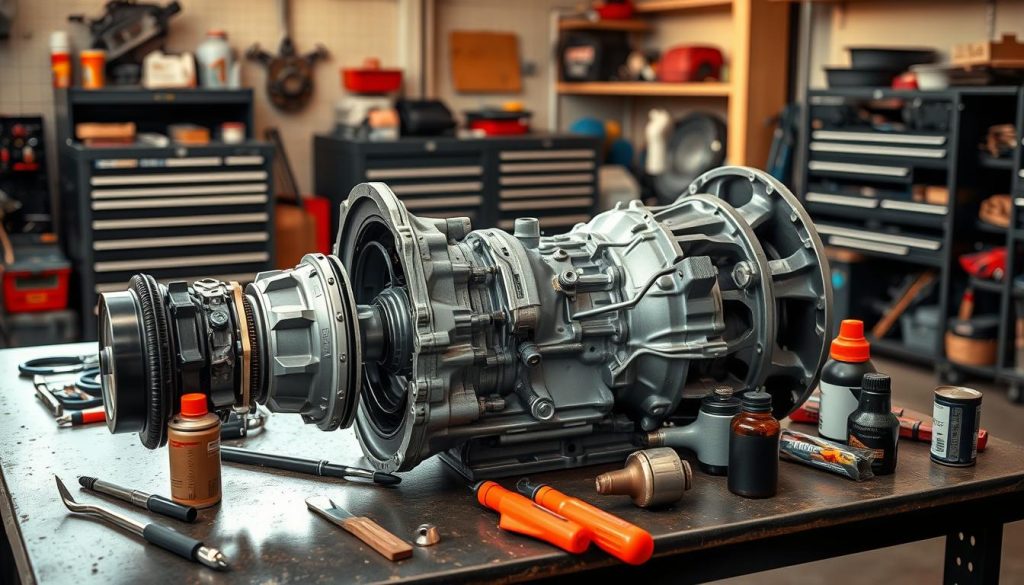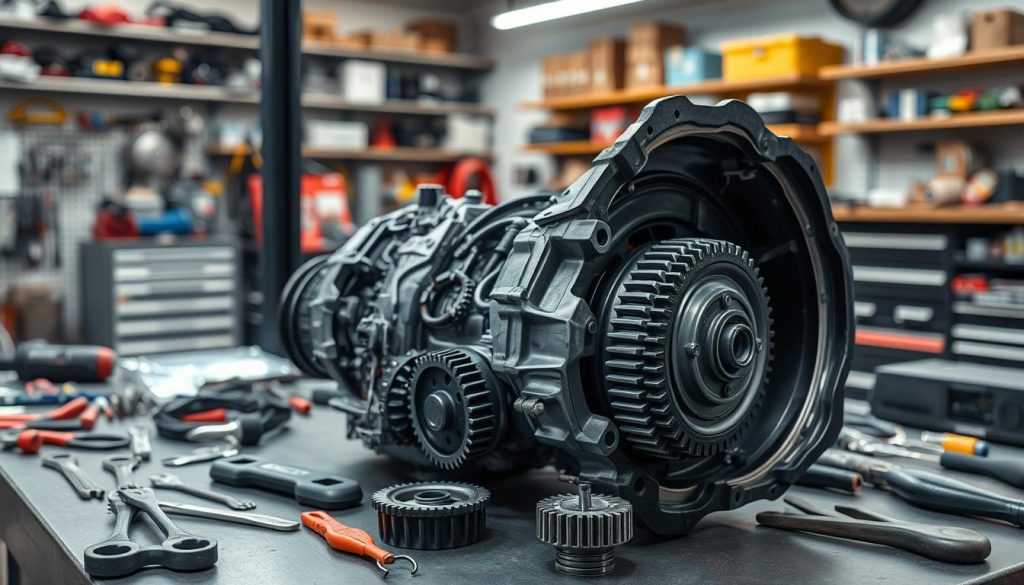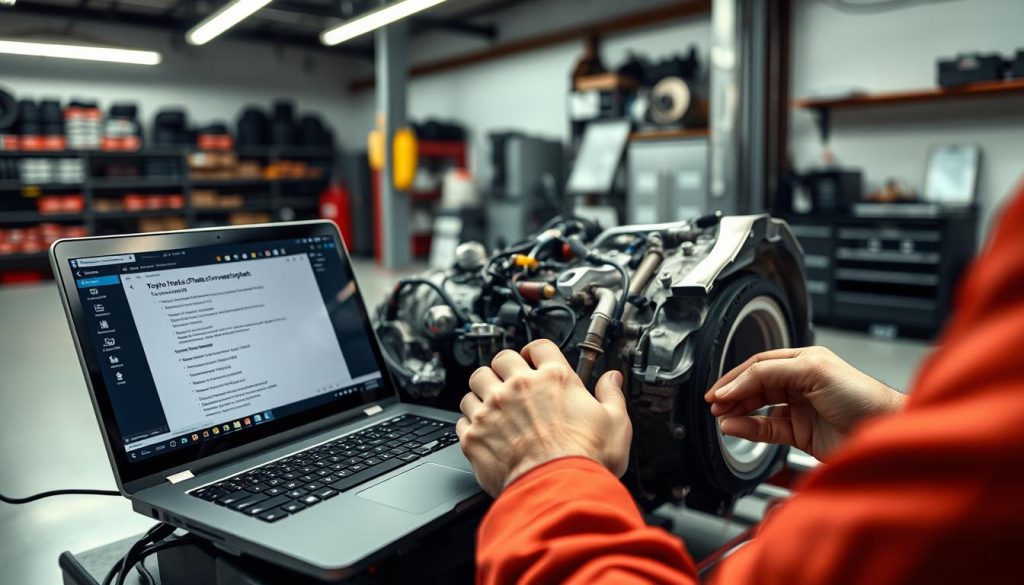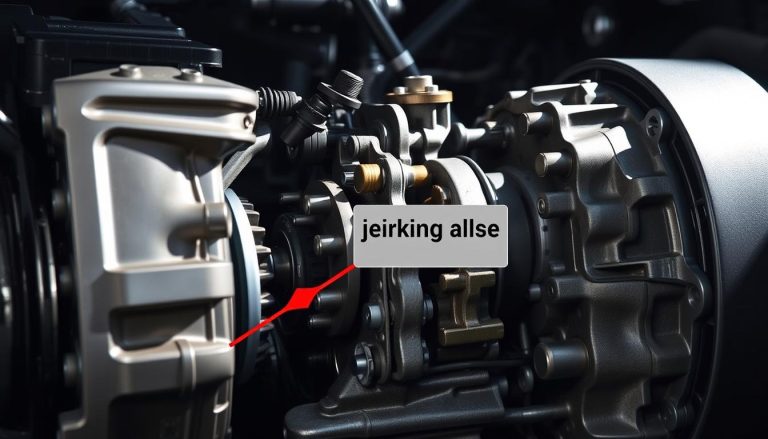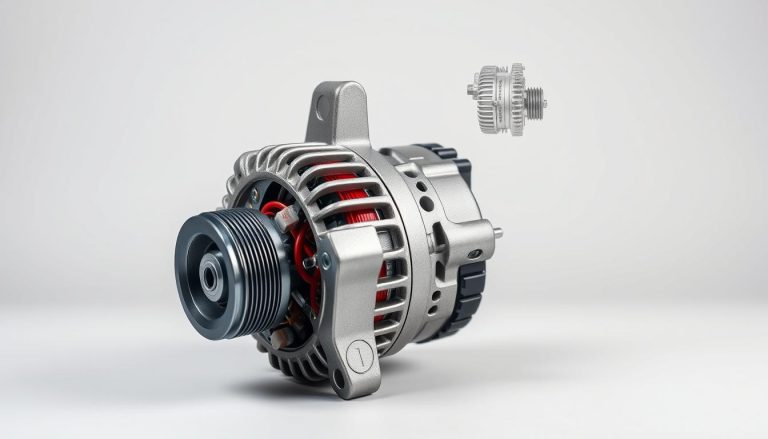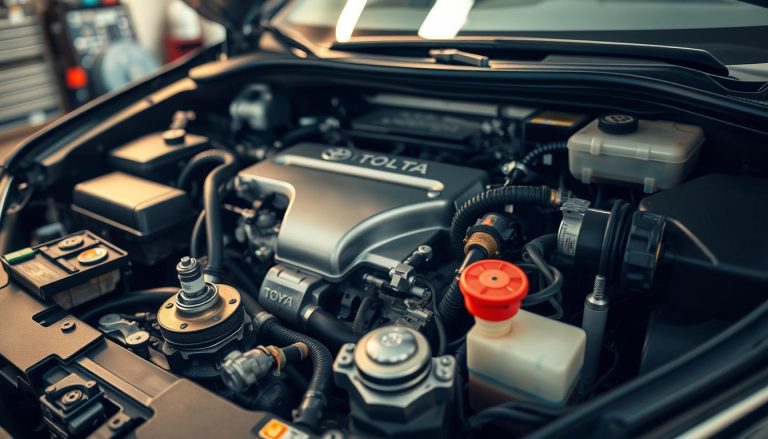Toyota Transmission Slipping? Here’s What to Do
Knowing how vital a working transmission is for your Toyota’s health is key. The transmission takes the engine’s power and moves your car. If your Toyota’s transmission starts slipping or making odd noises, you must act fast. This can stop bigger, pricier issues later on.
Toyota cars are known for being dependable. Yet, they can face transmission troubles too. These issues can hurt how well your car runs and its lifespan.
Introduction to Toyota Transmission Problems
Understanding Toyota transmission issues is key to keeping your car running well. Regular Toyota transmission maintenance can spot and fix problems early. This keeps your drive smooth and enjoyable.
Why Transmission Issues are Critical
Transmission problems can really hurt your car’s performance and safety. Issues like slow gear changes, slipping, or odd noises can make your Toyota unreliable. Fixing these problems with Toyota transmission repair makes driving safer and keeps your car in good shape. Quick action can also save you money and keep your car running smoothly.
Common Transmission Problems in Toyota Vehicles
Toyota cars often face common transmission issues that need Toyota transmission repair or maintenance. These include:
- Low or dirty transmission fluid
- Worn-out clutch parts
- Bad sensors
- Mechanical wear from lack of maintenance
Sticking to a regular Toyota transmission maintenance schedule can prevent these problems. It keeps your Toyota running well and reliably.
Signs Your Toyota Transmission Needs Attention
Keeping your Toyota’s transmission in good shape is key for its long life and performance. Spotting problems early can prevent big failures and expensive fixes. Watch out for certain signs that mean it’s time for a Toyota transmission service or Toyota transmission diagnosis.
Recognizing Symptoms Early
Transmission trouble often starts with small signs. These signs are important to catch and fix right away. Look out for:
- Unusual delays when shifting gears
- A distinct burning smell, often indicating overheated transmission fluid
- Transmission fluid leaks
- Warning lights on the dashboard related to the transmission system
Other signs might be strange noises like clunking or whining while driving. These need a detailed Toyota transmission diagnosis to find the problem.
Importance of Addressing Issues Promptly
It’s vital to act fast when you notice transmission problems. Waiting too long can make things worse, leading to big repair bills and car downtime. Quick Toyota transmission service can stop small issues from getting bigger, keeping your car safe and running well.
Fixing problems early not only makes your Toyota last longer but also makes driving smoother and more reliable.
| Symptom | Potential Issue | Recommended Action |
|---|---|---|
| Delayed shifting | Transmission fluid low or degraded | Check and change transmission fluid |
| Burning smell | Overheated transmission fluid | Immediate Toyota transmission service |
| Transmission fluid leaks | Worn seals or gaskets | Inspect and replace leaking components |
| Warning lights | System alert for various possible issues | Toyota transmission diagnosis |
Understanding Toyota Transmission Slipping
Transmission slipping is a common issue that can affect your Toyota’s performance. It’s important to know the symptoms and causes to fix it. This helps keep your vehicle in good shape.
What is Transmission Slipping?
Transmission slipping happens when your engine revs but the car doesn’t move as it should. You might notice a delay in gear shifting or feel the car lagging. This is a sign that your transmission needs attention right away.
Common Causes of Transmission Slipping
Several factors can cause transmission slipping. Here are the main reasons:
- Low Transmission Fluid: Low Toyota transmission fluid is a common cause. Fluid levels can drop due to leaks or not checking it often enough.
- Wear and Tear on Components: As your car gets older, its transmission parts can wear out. This is a common problem in older Toyotas.
- Transmission Control Module Issues: Problems with the transmission control module can cause bad gear changes and unpredictable behavior.
Finding out why your transmission is slipping early is key. Regular checks and maintenance of your Toyota transmission fluid can stop big problems. It also keeps your car running smoothly.
Common Causes of Transmission Issues in Toyota Vehicles
Knowing why Toyota transmissions have problems is key to keeping your car running well. Low or dirty transmission fluid is a big problem. It can make your car’s transmission slip. Always check and replace the fluid as needed.
Worn-out clutch parts are another big issue, mainly in manual transmissions. The clutch wears down over time, causing problems with gear changes. This wear can lead to your car’s transmission slipping, showing the importance of regular car care.
Also, faulty transmission sensors can cause problems with shifting gears. These sensors send important signals to the transmission. If they don’t work right, shifting can become rough.
Lastly, mechanical wear from age or lack of care can really hurt your transmission. Regular checks and quick fixes can stop these problems. They help keep your Toyota running smoothly and last longer.
How to Detect Toyota Transmission Problems
Keeping your vehicle running well means spotting problems early. Knowing how to diagnose a Toyota transmission is key. It helps fix issues before they get worse.
Dashboard Warning Lights
Dashboard lights are your first clue to transmission trouble. If the transmission temperature or check engine light comes on, it’s time to act. Regular checks can often stop these lights from flashing.
Unusual Noises and Sensations
Listen for strange sounds like whining or clunking. These noises can mean big problems inside. Also, watch for rough or slow gear shifts. Catching these signs early helps keep your transmission in top shape.
Checking Transmission Fluid Levels and Quality
It’s important to keep your Toyota’s transmission fluid in good shape. This helps avoid big problems with the transmission. We’ll show you how to check the fluid levels and spot any signs of contamination.
How to Check Transmission Fluid
To check Toyota transmission fluid levels, first find the transmission dipstick. Here’s what to do:
- Make sure the car is on a flat surface and the engine is warm.
- Find the dipstick, usually at the back of the engine bay.
- Take out the dipstick and clean it with a lint-free cloth.
- Put the dipstick back in and pull it out again to see the fluid level.
- The fluid should be at the marked levels on the dipstick.
Keeping the Toyota transmission fluid at the right level is key. It helps prevent and fix transmission problems in Toyota cars.
Signs of Contaminated Fluid
It’s just as important to watch the quality of your transmission fluid as its level. Bad fluid can cause serious transmission issues Toyota cars face. Here are some signs of bad fluid:
- Fluid color: Good transmission fluid is bright red. If it’s dark or brown, it’s contaminated.
- Smell: Clean fluid smells sweet or has no smell. A burnt smell means there might be internal problems.
- Texture: If the fluid feels gritty, it’s contaminated and might mean mechanical wear.
Checking both the fluid level and quality regularly is key. It keeps your Toyota’s transmission running well and lasts longer.
DIY Solutions for Minor Transmission Issues
Fixing minor transmission problems yourself can save you time and money. Simple steps like resetting the Transmission Control Module and driving carefully can help. These actions can make your car’s transmission last longer.
Resetting the Transmission Control Module
For small electronic problems in your Toyota transmission, resetting the Transmission Control Module (TCM) might solve it. This action refreshes the system, possibly fixing Toyota transmission slipping. Here’s how to reset the TCM:
- Turn the ignition key to the “On” position without starting the engine.
- Press and hold the gas pedal for about 10 seconds.
- Release the gas pedal and turn the ignition key to the “Off” position.
- Wait a few seconds, then start the engine to complete the reset.
Maintaining Proper Driving Habits
Good driving habits are key to keeping your transmission in good shape. Here are some tips:
- Avoid aggressive driving, including rapid acceleration and hard braking.
- Do not exceed the recommended towing capacity to prevent unnecessary stress on the transmission.
- Regularly schedule a Toyota transmission service to ensure fluid levels and quality are optimal.
Following these tips can stop Toyota transmission slipping and improve your car’s performance.
Importance of Regular Transmission Maintenance
Keeping your Toyota transmission in good shape is key for its smooth running and long life. Regular Toyota transmission maintenance catches problems early, avoiding expensive fixes. Changing the fluid regularly stops dirt and damage.
It’s also vital to have your transmission checked by experts often. They can find small issues before they get big. This care keeps your car running well and saves you money and time.
By regularly taking care of your transmission, your car stays reliable and efficient. Adding these steps to your car care routine is a smart move.
When to Seek Professional Help
If DIY fixes don’t solve your transmission problems, it’s time to get help from experts. They can do a detailed Toyota transmission diagnosis to find the real cause of the issues.
Diagnostic Scans and What They Reveal
Advanced diagnostic scans can find specific problems in your transmission. They check both electronic and mechanical parts. This shows if the issue is with sensors or if there’s wear and tear inside.
Tools used by pros can quickly spot trouble codes and performance data. This helps them know exactly what repairs are needed.
Mechanical Inspections by Experts
A detailed mechanical inspection by skilled technicians can find hidden problems. They look beyond the surface to find wear, leaks, and other small issues that might not be seen easily.
Getting your Toyota’s transmission checked thoroughly keeps it in top shape. It helps avoid costly repairs and ensures your car runs smoothly.
Types of Professional Transmission Repairs
If your Toyota transmission is slipping, getting it fixed by a pro is key. There are many types of repairs, depending on the problem. Here’s a look at what certified techs might suggest:
- Minor Adjustments: Sometimes, just a tweak is needed. This could be adjusting the transmission control module or the shift linkage.
- Fluid Changes: Checking and changing the transmission fluid is a first step. Old or dirty fluid can cause slipping.
- Part Replacement: If certain parts like clutches, gears, or solenoids need fixing, replacing them can solve the problem.
- Full Overhaul: For serious problems, a full overhaul might be needed. This means taking the transmission apart, checking each part, and replacing any that are worn or damaged.
- Transmission Rebuild: A rebuild involves swapping out old parts for new ones. This can improve performance and make the transmission last longer.
Certified techs use special tools to find out what’s wrong and suggest the best fix. This way, your car will run smoothly and reliably again.
| Repair Type | Description | Suitability |
|---|---|---|
| Minor Adjustments | Adjusting transmission control modules or shift linkages | Great for minor issues or initial troubleshooting |
| Fluid Change | Replacing old or contaminated transmission fluid | Effective for slipping caused by fluid quality |
| Part Replacement | Replacing specific components like clutches or gears | Ideal for localized issues within the transmission |
| Full Overhaul | Disassembling and inspecting all transmission parts | Necessary for severe or widespread issues |
| Transmission Rebuild | Replacing worn components and upgrading parts | Best for performance enhancement and durability |
Preventive Measures to Avoid Transmission Problems
To keep your Toyota’s transmission running well, focus on two main steps: regular fluid changes and using genuine Toyota parts. These actions can greatly improve your car’s performance and lifespan.
Regular Fluid Changes
Changing your transmission fluid regularly is key to Toyota transmission maintenance. Clean fluid is essential for your car’s transmission to work smoothly. It helps remove harmful particles that can damage your transmission.
- Check fluid levels monthly
- Use only Toyota-recommended fluid
- Consult your owner’s manual for specific intervals
Using Genuine Toyota Parts
For Toyota transmission service, always choose genuine Toyota parts. These parts are made to fit your vehicle perfectly and work better. Using aftermarket parts can lead to problems later on.
- Better compatibility and performance
- Higher reliability and durability
- Preservation of vehicle warranty
Cost Considerations for Transmission Repairs
When you face Toyota transmission problems, knowing the costs is key. The price of Toyota transmission repair changes a lot. Small fixes like fluid changes or part swaps are cheaper. But, big issues like a new transmission can cost a lot more.
| Transmission Repair Type | Estimated Cost |
|---|---|
| Fluid Change | $100 – $250 |
| Transmission Flush | $150 – $300 |
| Shift Solenoid Replacement | $150 – $400 |
| Torque Converter Replacement | $600 – $1,000 |
| Full Transmission Rebuild | $1,500 – $3,000 |
| Complete Transmission Replacement | $3,500 – $7,000 |
Many things affect repair costs, like part availability and local labor rates. So, getting quotes from trusted mechanics is smart. This way, you can plan better and avoid surprise costs when fixing Toyota transmission problems.
Role of Software Updates in Transmission Performance
Software updates are key to better transmission performance in Toyota cars. They improve the efficiency and reliability of your car’s transmission. This ensures your car runs at its best.
Transmission Control Module Reprogramming
The Transmission Control Module (TCM) is a critical part that controls the transmission. It’s often updated during a Toyota transmission service. This update fixes issues like delayed shifting and erratic patterns.
Regular maintenance, including TCM updates, keeps your transmission in sync with driving conditions. It also adds new features. Authorized Toyota service centers do this, making sure your car gets the best updates.
Benefits of the Latest Software Updates
Getting the latest software updates has many advantages:
- Improved Shift Response: The TCM updates make gear changes smoother.
- Extended Lifespan: New software reduces wear and tear, making your transmission last longer.
- Enhanced Fuel Efficiency: Better transmission behavior means better fuel economy.
- Resolved Known Issues: Updates often fix previous transmission problems.
Keeping up with Toyota transmission service and maintenance keeps your car in great shape. It uses the latest technology to improve your driving experience and reliability.
Driving Tips to Protect Your Toyota Transmission
Keeping your Toyota’s transmission in good shape means driving smart. This helps avoid problems like *Toyota transmission slipping*. Here are some important tips to keep your vehicle’s transmission healthy:
- Avoid harsh acceleration and deceleration: Sudden starts and stops can damage your transmission. This can cause it to wear out faster and lead to common issues.
- Use the appropriate gear for driving conditions: Always choose the right gear for your speed. This reduces stress on your transmission and prevents slipping.
- Regular maintenance checks: Regular inspections and following Toyota’s maintenance schedule are key. They keep your transmission fluid clean and at the right level, preventing problems.
By following these driving tips, you can make your Toyota’s transmission last longer. This helps avoid issues like *Toyota transmission slipping*. Taking care of your transmission now can save you money and make driving smoother.
Conclusion
Managing Toyota transmission problems requires regular care and quick action when symptoms appear. Knowing how to handle these issues is key. Early signs and quick fixes are vital for your car’s long life and reliability.
Creating a maintenance plan for your Toyota’s transmission is essential. This includes checking fluids often and using genuine parts. Also, keeping up with software updates and driving wisely helps avoid damage. These steps help your car run better and last longer.
Learning about your Toyota’s transmission needs helps you make smart choices. This knowledge keeps your car in top shape and gives you peace of mind. Remember, regular care and quick repairs are the best way to keep your Toyota running smoothly for years.
FAQ
Why are transmission issues critical for my Toyota vehicle?
Transmission problems are key because they impact your car’s performance, safety, and lifespan. Ignoring these issues can lead to costly repairs. This might turn your reliable Toyota into a big problem.
What are common transmission problems in Toyota vehicles?
Toyota vehicles often face issues like low or dirty transmission fluid. Worn clutch parts in manual transmissions and faulty sensors can also cause problems. Aging or lack of maintenance can lead to mechanical wear.
What are the signs that my Toyota transmission needs attention?
Look out for signs like unusual delays when shifting gears or a burning smell from the transmission. Also, watch for fluid leaks and dashboard warning lights. Catching these early is key.
What is transmission slipping?
Transmission slipping happens when the car doesn’t speed up when the engine does. It can also change gears unexpectedly. This is often due to low fluid, wear, or issues with the control module.
How can I detect transmission problems in my Toyota?
Check for dashboard lights, odd noises, and unusual driving sensations. Also, check the transmission fluid’s quality. It should be clear and smell slightly sweet.
How do I check the transmission fluid in my Toyota?
To check the fluid, find the dipstick, pull it out, and look at the fluid. It should be clear and smell slightly sweet. Dark or gritty fluid means it’s contaminated and needs attention.
What are some DIY solutions for minor transmission issues?
Try resetting the Transmission Control Module for electronic glitches. Also, avoid aggressive driving to keep your Toyota’s transmission in good shape.
How important is regular transmission maintenance for my Toyota?
Regular maintenance, like fluid changes and inspections, is vital. It prevents problems and keeps your Toyota running smoothly. This approach saves time and money by catching issues early.
When should I seek professional help for transmission issues?
If DIY fixes don’t work, get professional help. Technicians can do detailed scans and inspections. They’ll fix your Toyota’s transmission properly.
What types of professional transmission repairs are available?
Repairs range from small adjustments to major overhauls. This depends on the problem’s severity. You might need to replace parts like clutches or the whole transmission.
What preventive measures can I take to avoid transmission problems?
Regular fluid changes and using genuine Toyota parts are key. These steps help keep your transmission reliable and long-lasting.
How much can repairing a Toyota transmission cost?
Repair costs vary based on the damage and type of repair. Minor fixes are cheaper, but major repairs, like a new transmission, can be expensive.
What role do software updates play in transmission performance?
Software updates improve performance by fixing issues and adjusting operational parameters. They help your transmission work better and last longer.
What are some driving tips to protect my Toyota transmission?
Drive carefully by avoiding harsh acceleration and deceleration. Use the right gear for the road conditions. Regular maintenance checks also help keep your transmission in top shape.





